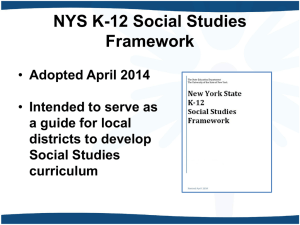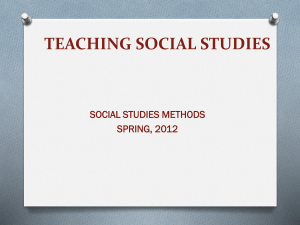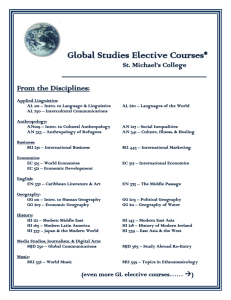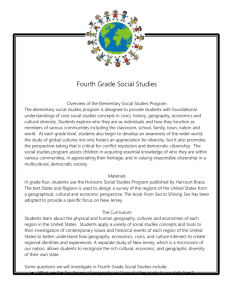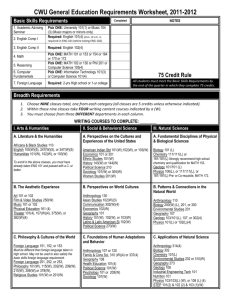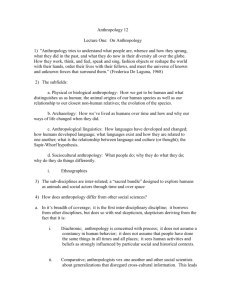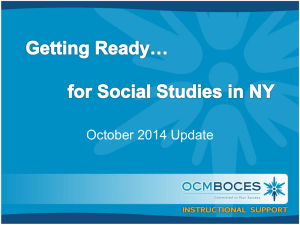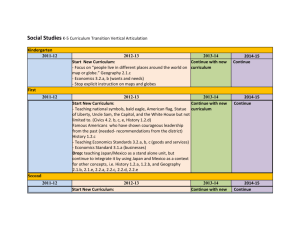Anthropology - Boulder Valley School District
advertisement
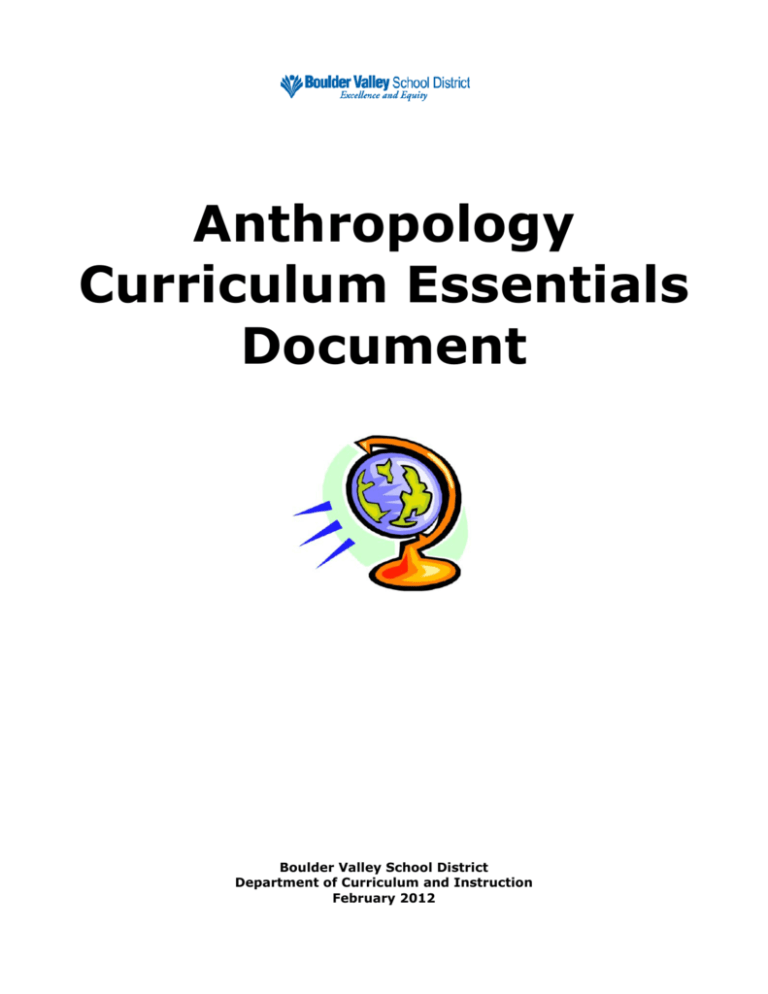
Anthropology Curriculum Essentials Document Boulder Valley School District Department of Curriculum and Instruction February 2012 Introduction The Social Studies curriculum council began meeting in the Fall of 2007. This curriculum is a result of their focused attention and ability to examine and incorporate research about best practices in education. The work that follows incorporates the ideas of many researchers‐including Robert Marzano, Joseph Kahne, Virginia Gay, Christine Sleeter, and Randall Lindsey. Each of whom addressed one or more of our goals: • • • • • • Viability Culturally Proficiency Currency Incorporates New Century Graduate Characteristics Addresses the Democracy Divide Viability In order to create a curriculum that can be taught using the teaching learning cycle, each content area was trimmed, in order to emphasize depth in our instruction. Creating a viable curriculum will help us in our efforts to close the achievement gap. Cultural Proficiency Just as the goals of BVSD embrace increasing the cultural proficiency of the district, this curriculum is designed to do so for the learner. Lindsey identifies 5 strategies for moving toward cultural proficiency: Know your differences, value difference, manage conflict, adapt to diversity and teach about culture. These skills are built into every grade level curricula. By introducing cultures not previously emphasized in our curriculum, allowing for cultural relevancy by bringing the students’ culture into the classroom, and by incorporating a variety of perspectives on essential issues, this curriculum will be a step in moving our system forward in embracing difference, and narrowing our achievement gap. Currency What does a current curriculum look like? Our current students will face a world very unlike our own. We addressed five issues to bring currency into the curriculum: 1. Change‐ In the fast paced world our students encounter there is one theme that they will need the skills to address in their lives: Change. The theme of change: observing change, predicting change, adapting to change and creating change are imbedded ideas at every level. 2. Regional Focus‐ Additionally, the content focus has shifted to increase attention on Asia. 3. Current Events‐ Each grade level will be responsible for bringing in grade appropriate discussion of current events. 4. Technology‐ An up‐to‐date social studies curriculum will embrace the technological tools that not only enhance the social studies but make new learning possible. The US department of Labor states that careers involving the use of Geospatial technologies are one of the top 14 careers of the future. These careers will be as diverse as remote sensing, data collection, environment and urban planning, and digital cartography. The opening of Geospatial technologies to students as young as kindergarten will open new avenues to understanding and analyzing our world. 5. Economics‐ As a final update, we have increased the amount and frequency of economic content at every level. As our students enter a world of complex economics, we responded to the needs shown in our society. 3/8/2012 BVSD Curriculum Essentials 2 Anthropology Overview Course Description Topics at a Glance This course provides a survey within the discipline in Anthropology. The course can be divided into major themes: Physical Anthropology and Cultural Anthropology. Within these two themes, an overview of the major topics in an introductory Anthropology course is provided. PHYSICAL ANTHROPOLOGY Biological Anthropology Evolution, natural selection, Charles Darwin, primatology, bipedalism, human family tree (Ardipethicus, Australopithecus, Homo), human migration, domestication, Paleolithic Era (Upper and Lower) vs. Neolithic Era Archaeology Archaeology, process of excavation, ecofacts, different types of dating (radiocarbon, thermoluminescence, etc), site and settlement patterns, new technologies in archaeology (satellite imaging and ground-penetrating radar), historic preservation CULTURAL ANTHROPOLOGY Linguistic Anthropology Language families, phonetics, kinesics, non-verbal language, gesture-call system, etymology, pidgin languages, role of English in globalization, paralanguage (including digital language) Cultural Anthropology Culture, culture universals, religion vs. spirituality, animism, animatism, monotheism, polytheism, gender roles, patriarchal and matriarchal descent, social stratification, economic anthropology, pastoral vs. industrial societies Assessments • Teacher Assessments 3/8/2012 Useful Information: • Topics include, but are not limited to • Topics-at-a-glance must be included in any BVSD Anthropology course, but do NOT have to be organized into the two units provided. • Use broad themes and embed details. • Use current events to address issues and current realities. BVSD Curriculum Essentials 3 Content Area: Social Studies GRADE LEVEL/COURSE EXPECTATION: ANTHROPOLOGY - High School (Elective) Prepared Graduates: Examine the role of biological and cultural factors in the evolution of humans over time Grade Level Expectation Concepts and skills students master: 1. Explain the role of humans in the animal kingdom over time using biological perspective to understand the anatomical similarities and differences particularly among primates Evidence Outcomes 21st Century Skill and Readiness Competencies Students Can: a. Identify the different types of human species over time b. Analyze the anatomical differences between humans and non-human primates c. Understand the role of natural selection d. Locate the migration of humans out of Africa e. Analyze the role of domestication in human cultural evolution Inquiry Questions: 1. What makes us human? 2. What is the role of natural selection in human adaptation? 3. How have human species changed over time? 4. How does culture impact human evolution? 5. Was the Neolithic Revolution a revolution? 3/8/2012 BVSD Curriculum Essentials Relevance and Application: 1. Humans have become one of the only species to populate all regions of the world, and have the largest capacity to manipulate the natural environment. For example, humans have domesticated plants and animals, settled and adapted in inhospitable environments, and have evolved distinctive cultural adaptations to the various environments that have been created. 2. Biological changes in the various human species over time have allowed them to separate from our primate ancestors, most notably our bipedal abilities that have moved us out of a tree-living existence. 3. Human species have changed and adapted over time, eventually resulting in only one remaining type of modern human, which helps make physical characteristics such as race irrelevant to studying physical human differences. 4. Culture is one of the key factors that is now used to identify different groups and societies of humans, but is also the key element in modern human evolution. Culture could play a key role in the predictions of global problems and solutions. 5. The Neolithic Revolution marks a distinct moment in which cultural adaptation begins to move faster than biological adaptation, allowing 4 humans to become the most influential specie on the planet. Nature of Discipline: 1. Physical anthropologists understand the physiological differences between humans and their primate counterparts. 2. Physical anthropologists use evolution and natural selection to analyze anatomical characteristics of humans and other bipeds. 3. Physical anthropologists recognize the Neolithic Revolution as a key turning point in the role of culture in human evolution. 3/8/2012 BVSD Curriculum Essentials 5 Content Area: Social Studies GRADE LEVEL/COURSE EXPECTATION: ANTHROPOLOGY - High School (Elective) Prepared Graduates: Examine the biological and cultural factors in the evolution of humans over time Grade Level Expectation Concepts and skills students master: 2. Explain how studying geology, cultural artifacts, environmental changes and biology are integral to archaeologists in the scientific study of humans physical anthropologists and Evidence Outcomes 21st Century Skill and Readiness Competencies Students Can: a. Apply the study of geology and environmental changes to investigate chances in human evolution b. Identify, evaluate, and communicate strategies to investigate new archaeological sites and finds c. Explain how new technologies are allowing archaeologists and anthropologists to uncover new information and fossilized evidence Inquiry Questions: 1. What are the different techniques used to locate and identify archaeological evidence? 2. How have environmental changes over time caused adaptations in humans? 3. How can technology change and advance anthropology and archaeology? Relevance and Application: 1. Various investigative techniques are used to analyze fossilized evidence which includes, but is not limited to radio carbon dating, stratification analysis and ground-penetrating radar (GPR). 2. Cyclical changes in the environment over periods of history have caused many of the significant human changes over time. For example, the retreat of the last ice age altered many of the migrations and settlements of early modern humans. 3. As new technologies develop in the 21st century, archaeological investigations have become more common and more efficient which has allowed for new evidence to surface, thus changing or advancing many anthropological theories. Nature of Discipline: 1. Technology has altered and advanced the field of archaeology rapidly, creating new theories and revising old theories. 2. Archaeologists engage in critical thinking, the scientific method and inquiry to examine new sites and material. 3/8/2012 BVSD Curriculum Essentials 6 Content Area: Social Studies GRADE LEVEL/COURSE EXPECTATION: ANTHROPOLOGY - High School (Elective) Prepared Graduates: Understand the role of language and the development of linguistics in successful communication among human societies Grade Level Expectation Concepts and skills students master: 3. The role of language in humans and the differences within communication both cross-culturally and over time. Evidence Outcomes 21st Century Skill and Readiness Competencies Students Can: a. Identify the major language families and the epicenter of their origins b. Understand the role of communication in the transfer of cultural values and norms c. Analyze the differences between different types of nonverbal communication including paralanguages, body language and gesture-call systems d. Explain the factors that can contribute to the extinction or the preservation of languages Inquiry Questions: 1. How can communication be defined? 2. How has language promoted cooperation or conflict? 3. How does language influence cultures and subcultures? 4. How does increasing globalization influence the survival of languages on Earth? Relevance and Application: 1. The world is geographically interconnected, affecting daily life in such ways as the spread of disease, global impact of modern technology, and the impact of cultural diffusion. 2. Language, and the culture that languages can communicate, have often been the key factor that determines whether groups have lived peacefully, or have engaged in consistent conflict. 3. Different types of languages, including non-verbal languages, help communicate cultural values and norms. This is true for past cultures as well as those groups that are evolving in the 21st century. For example the role of digital language in the promotion of cultural norms in developed countries. 4. There are numerous factors that lead to either the preservation or extinction of languages over time. Globalization has led to an increasing importance in major languages like English, while forcing smaller languages of traditional communities into extinction. Nature of Discipline: 1. Linguists recognize the role of language a determining factor in defining civilization. 2. The role of language is an integral part of successful communication in societies of both past and present. 3/8/2012 BVSD Curriculum Essentials 7 Content Area: Social Studies GRADE LEVEL/COURSE EXPECTATION: ANTHROPOLOGY - High School (Elective) Prepared graduates: Explain the role of culture in the diversification of humans in various regions across the world Grade Level Expectation Concepts and skills students master: 4. Explain the different facets of culture, how they have evolved, how some traits are universal, and how subcultures have diverged from the mainstream Evidence Outcomes 21st Century Skill and Readiness Competencies Students Can: a. Identify cultural universals and universals that have formed within specific facets of culture (ex. universal traits in religions and other spiritual belief structures) b. Understand the foundations of religion and spirituality and the function it plays in societies c. Analyze how gender roles have changed over time and differ cross-culturally d. Evaluate the factors that influence the difference in relationships that include romantic and familial relationships e. Identify the different economic structures that have formed over time Inquiry Questions: 1. Why are some cultural traits universal? 2. Why has spirituality become so important to human existence? 3. How do gender roles parallel other social stratifications in society? 4. How is an economic system reflected in a society’s cultural values and norms? Relevance and Application: 1. All cultures share universal elements that create bonds between all humans and subgroups. These include worldview, material culture, economic systems, language and social organization. 2. Spiritual beliefs and religions are rooted in the attempt by humans to explain the inexplicable. Understanding the universal traits within religion could help provide solutions for religious conflict. 3. There are distinct differences between cultures that a socially stratified economically and politically, which is also reflected in gender roles. Traditional communities rooted in agrarian and egalitarian culture will reflect closer gender equality. 4. Economic systems from barter and trade to capitalism are often a result of cultural values that have already existed in society. Nature of Discipline: 1. Cultural anthropologists identify universal aspects of culture when examining groups of humans over time. 2. Cultural anthropologists identify universal aspects of culture when examining groups of humans across cultures. 3. Cultural anthropologists delineate cultural differences among groups to develop understandings between divergent belief structures. 3/8/2012 BVSD Curriculum Essentials 8 Prepared Graduate Competencies in Social Studies The prepared graduate competencies are the preschool through twelfth-grade concepts and skills that all students who complete the Colorado education system must master to ensure their success in a postsecondary and workforce setting. Prepared graduates in social studies: 1. Use the tools, thinking, and practices of history, geography, economics, and civics to: a. Solve problems, make decisions and analyze issues from multiple perspectives as a responsible member of society b. Read, write, and communicate ideas Prepared graduates in history: 1. Develop an understanding of how people view, construct, and interpret history 2. Analyze key historical periods and patterns of change over time within and across nations and cultures Prepared graduates in geography: 1. Develop spatial understanding, perspectives, and personal connections to the world 2. Examine places and regions and the connections among them Prepared graduates in economics: 1. Understand the allocation of scarce resources in societies through analysis of individual choice, market interaction, and public policy 2. Acquire the knowledge and economic reasoning skills to make sound financial decisions (PFL) Prepared graduates in civics: 1. Analyze and practice rights, roles, and responsibilities of citizens 2. Analyze the origins, structure, and functions of governments and their impacts on societies and citizens 3/8/2012 BVSD Curriculum Essentials 9 Standard High School 1. History Social Studies Grade Level Expectations at a Glance Grade Level Expectation 1. 2. 3. 2. Geography 1. 2. 3. 3. Economics 1. 2. 3. 4. 5. 6. 4. Civics 7. 1. 2. 3. Eighth Grade 1. History 1. 2. 2. Geography 1. 2. 3. Economics 1. 4. Civics 2. 1. 2. 3/8/2012 Use the historical method of inquiry to ask questions, evaluate primary and secondary sources, critically analyze and interpret data, and develop interpretations defended by evidence from a variety of primary and secondary sources Analyze the key concepts of continuity and change, cause and effect, complexity, unity and diversity over time Recognize the significance of ideas as powerful forces throughout history Use different types of maps and geographic tools to analyze features on Earth to investigate and solve geographic questions Explain and interpret geographic variables that influence the interaction of people, places, and environments Describe the interconnected nature of the world, its people and places Recognize that productive resources - natural, human, capital - are scarce; therefore choices are made about how individuals, businesses, governments, and societies allocate these resources Demonstrate how economic policies impact markets Analyze how government and competition impact markets Design, analyze, and apply a financial plan based on short- and long-term financial goals (PFL) Analyze strategic spending, saving, and investment options to achieve the objectives of diversification, liquidity, income, and growth (PFL) Identify the components of personal credit to manage credit and debt (PFL) Identify, develop, and evaluate risk-management strategies (PFL) Research, formulate positions, and engage in appropriate civic participation to address local, state, or national issues or policies Identify the purposes of and limitations on the foundations, structures and functions of government Analyze how public policy - domestic and foreign - is developed at the local, state, and national levels and compare how policy-making occurs in other forms of government Formulate appropriate hypotheses about United States history based on a variety of historical sources and perspectives Be familiar with the historical eras, individuals, groups, ideas and themes from the origins of the American Revolution through Reconstruction and their relationships with one another Use geographic tools to analyze patterns in human and physical systems Understand that conflict and cooperation occur over space and resources Recognize that economic freedom, including free trade, is important for economic growth Understand how to manage personal credit and debt(PFL) Analyze elements of continuity and change in the United States government and the role of citizens over time Recognize the place of law in a constitutional system BVSD Curriculum Essentials 10 Standard Seventh Grade 1. History Social Studies Grade Level Expectations at a Glance Grade Level Expectation 1. 2. 2. Geography 1. 3. Economics 2. 1. 2. 4. Civics 1. 2. Sixth Grade 1. History 1. 2. 2. Geography 3. Economics 4. Civics 1. 2. 1. 2. 1. 2. Fifth Grade 1. History 1. 2. 2. Geography 3. Economics 4. Civics 3/8/2012 1. 2. 1. 2. 1. 2. Seek and evaluate multiple historical sources with different points of view to investigate a historical question and to formulate and defend a thesis with evidence Be familiar with the historical eras, individuals, groups, ideas and themes within regions of the Eastern Hemisphere and their relationships with one another Use geographic tools to gather data and make geographic inferences and predictions Understand that regions have different issues and perspectives Understand that supply and demand influence price and profit in a market economy Recognize that the distribution of resources influences economic production and individual choices (PFL) Analyze the different forms of government and international organizations and their influence in the world community Compare how various nations define the rights, responsibilities and roles of citizens Analyze and interpret historical sources to ask and research historical questions Analyze the historical eras, individuals, groups, ideas and themes in regions of the Western Hemisphere and their relationships with one another Use geographic tools to solve problems Recognize that human and physical systems vary and interact Identify and analyze different economic systems Recognize that saving and investing are key contributors to financial well being (PFL) Analyze the interconnected nature of the United States to other nations Compare multiple systems of governments Analyze historical sources from multiple points of view to develop an understanding of historical context The historical eras, individuals, groups, ideas, and themes in North America from 1491 through the founding of the United States government Use various geographic tools and sources to answer questions about the geography of the United States Causes and consequences of movement Government and market structures influence financial institutions Utilizing financial institutions to manage personal finances (PFL) The foundations of citizenship in the United States The origins, structure, and functions of the United States government BVSD Curriculum Essentials 11 Standard Fourth Grade 1. History Social Studies Grade Level Expectations at a Glance Grade Level Expectation 1. 2. 2. Geography 1. 2. 3. Economics 4. Civics Third Grade 1. History 1. 2. 1. 2. 1. 2. 2. Geography 1. 2. 3. Economics 1. 4. Civics 2. 1. 2. Second Grade 1. History 1. 2. 2. Geography 1. 2. 3. Economics 1. 4. Civics 2. 1. 2. 3/8/2012 Organize a sequence of events to understand the concepts of chronology and cause and effect in the history of Colorado The historical eras, individuals, groups, ideas, and themes in Colorado history and their relationships to key events in the United States Use several types of geographic tools to answer questions about the geography of Colorado Connections within and across human and physical systems are developed People responded to positive and negative incentives The relationship between choice and opportunity cost (PFL) Analyze and debate multiple perspectives on an issue The origins, structure, and functions of the Colorado government Use a variety of sources to distinguish historical fact from fiction People in the past influenced the development and interaction of different communities and regions Use various types of geographic tools to develop spatial thinking The concept of regions is developed through an understanding of similarities and differences in places Describe producers and consumers and how goods and services are exchanged Describe how to meet short-term financial goals (PFL) Respecting the views and rights of others as components of a democratic society The origin, structure and function of local government Identify historical sources and utilize the tools of a historian People in the past influenced the history of neighborhoods and communities Use geographic terms and tools to describe space and place People in communities manage, modify, and depend on their environment The scarcity of resources affects the choices of individuals and communities Apply decision-making processes to financial decision making(PFL) Responsible community members advocate for their ideas People use multiple ways to resolve conflicts or differences BVSD Curriculum Essentials 12 Standard First Grade 1. History Social Studies Grade Level Expectations at a Glance Grade Level Expectation 1. 2. Geography 2. 1. 2. 3. Economics 1. 4. Civics 2. 1. 2. Kindergarten 1. History 1. 2. 2. Geography 1. 3. Economics 1. 2. 1. 2. 4. Civics Preschool 1. History 2. Geography 3. Economics 4. Civics 3/8/2012 1. 1. 1. 2. 1. 2. Describe patterns and chronological order of events of the recent past Family and cultural traditions in the United States in the past Geographic tools such as maps and globes to represent places People in different groups and communities interact with each other and the environment People work at different types of jobs and in different types of organizations in order to produce goods and services and receive an income Identify short term financial goals (PFL) Effective groups have responsible leaders and team members Notable people, places, holidays and patriotic symbols Ask questions, share information and discuss ideas about the past The first component in the concept of chronology is to place information in sequential order People belong to different groups and live in different settings around the world that can be found on a map or globe Ownership as a component of economics Discuss how purchases can be made to meet wants and needs (PFL) Participate in making decisions using democratic traditions Civic participation takes place in multiple groups Change and sequence over time Develop spatial understanding, perspectives, and connections to the world People work to meet wants Recognize money and identify its purpose (PFL) Individuals have unique talents but also work with others in groups Rules and their purpose in allowing groups to work effectively BVSD Curriculum Essentials 13 Glossary of Terms 3/8/2012 BVSD Curriculum Essentials 14
